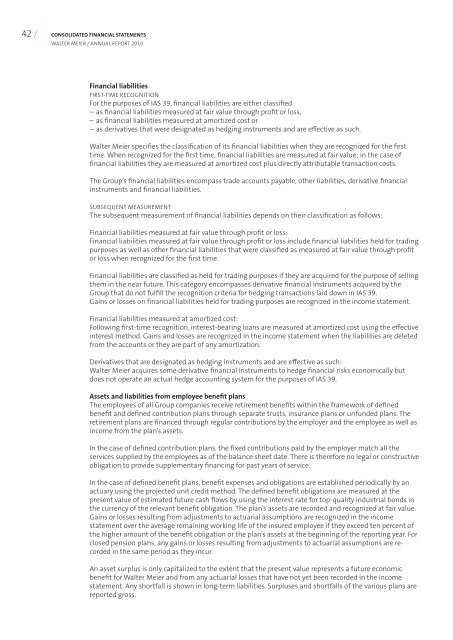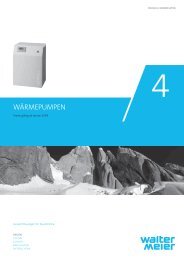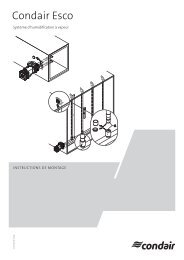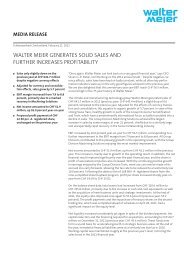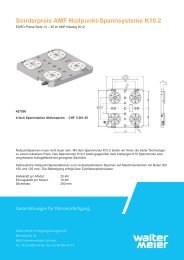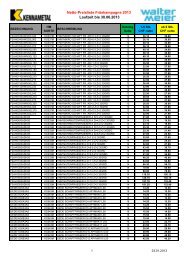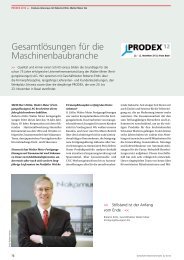AnnuAl report 2010 - Walter Meier
AnnuAl report 2010 - Walter Meier
AnnuAl report 2010 - Walter Meier
Create successful ePaper yourself
Turn your PDF publications into a flip-book with our unique Google optimized e-Paper software.
42 / Consolidated FinanCial statements<br />
<strong>Walter</strong> <strong>Meier</strong> / annual <strong>report</strong> <strong>2010</strong><br />
Financial liabilities<br />
FirSt-tiMe reCoGnition<br />
For the purposes of iaS 39, financial liabilities are either classified<br />
– as financial liabilities measured at fair value through profit or loss,<br />
– as financial liabilities measured at amortized cost or<br />
– as derivatives that were designated as hedging instruments and are effective as such.<br />
<strong>Walter</strong> <strong>Meier</strong> specifies the classification of its financial liabilities when they are recognized for the first<br />
time. When recognized for the first time, financial liabilities are measured at fair value; in the case of<br />
financial liabilities they are measured at amortized cost plus directly attributable transaction costs.<br />
the Group’s financial liabilities encompass trade accounts payable, other liabilities, derivative financial<br />
instruments and financial liabilities.<br />
SuBSequent MeaSureMent<br />
the subsequent measurement of financial liabilities depends on their classification as follows:<br />
Financial liabilities measured at fair value through profit or loss:<br />
Financial liabilities measured at fair value through profit or loss include financial liabilities held for trading<br />
purposes as well as other financial liabilities that were classified as measured at fair value through profit<br />
or loss when recognized for the first time.<br />
Financial liabilities are classified as held for trading purposes if they are acquired for the purpose of selling<br />
them in the near future. this category encompasses derivative financial instruments acquired by the<br />
Group that do not fulfill the recognition criteria for hedging transactions laid down in iaS 39.<br />
Gains or losses on financial liabilities held for trading purposes are recognized in the income statement.<br />
Financial liabilities measured at amortized cost:<br />
Following first-time recognition, interest-bearing loans are measured at amortized cost using the effective<br />
interest method. Gains and losses are recognized in the income statement when the liabilities are deleted<br />
from the accounts or they are part of any amortization.<br />
Derivatives that are designated as hedging instruments and are effective as such:<br />
<strong>Walter</strong> <strong>Meier</strong> acquires some derivative financial instruments to hedge financial risks economically but<br />
does not operate an actual hedge accounting system for the purposes of iaS 39.<br />
assets and liabilities from employee benefit plans<br />
the employees of all Group companies receive retirement benefits within the framework of defined<br />
benefit and defined contribution plans through separate trusts, insurance plans or unfunded plans. the<br />
retirement plans are financed through regular contributions by the employer and the employee as well as<br />
income from the plan’s assets.<br />
in the case of defined contribution plans, the fixed contributions paid by the employer match all the<br />
services supplied by the employees as of the balance sheet date. there is therefore no legal or constructive<br />
obligation to provide supplementary financing for past years of service.<br />
in the case of defined benefit plans, benefit expenses and obligations are established periodically by an<br />
actuary using the projected unit credit method. the defined benefit obligations are measured at the<br />
present value of estimated future cash flows by using the interest rate for top-quality industrial bonds in<br />
the currency of the relevant benefit obligation. the plan’s assets are recorded and recognized at fair value.<br />
Gains or losses resulting from adjustments to actuarial assumptions are recognized in the income<br />
statement over the average remaining working life of the insured employee if they exceed ten percent of<br />
the higher amount of the benefit obligation or the plan’s assets at the beginning of the <strong>report</strong>ing year. For<br />
closed pension plans, any gains or losses resulting from adjustments to actuarial assumptions are recorded<br />
in the same period as they incur.<br />
an asset surplus is only capitalized to the extent that the present value represents a future economic<br />
benefit for <strong>Walter</strong> <strong>Meier</strong> and from any actuarial losses that have not yet been recorded in the income<br />
statement. any shortfall is shown in long-term liabilities. Surpluses and shortfalls of the various plans are<br />
<strong>report</strong>ed gross.


